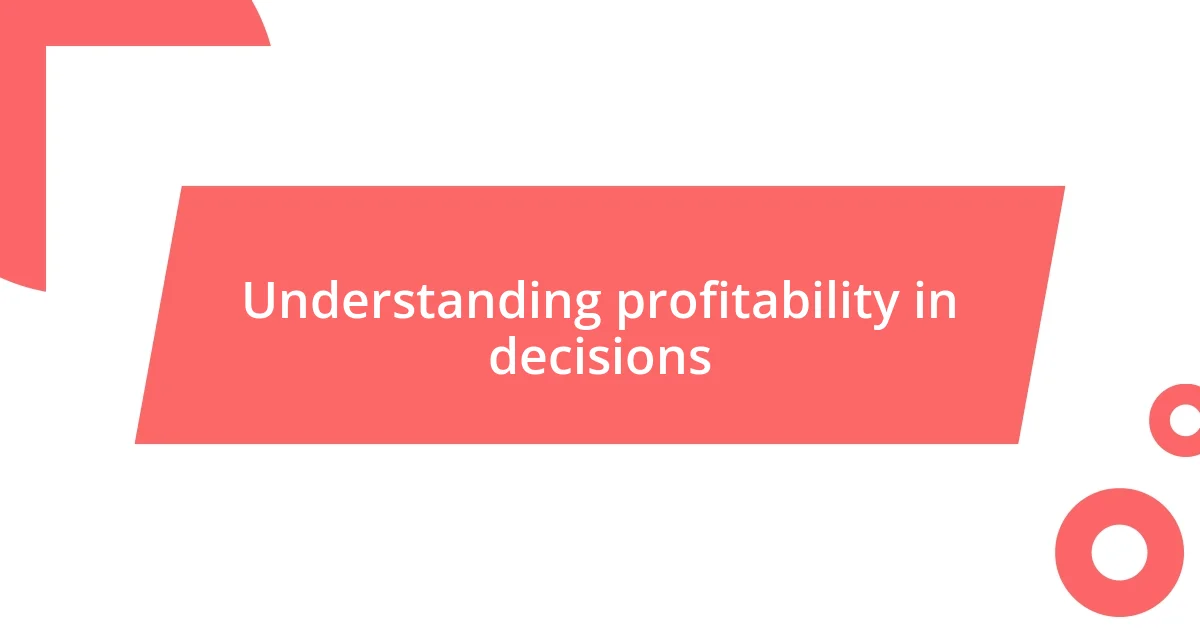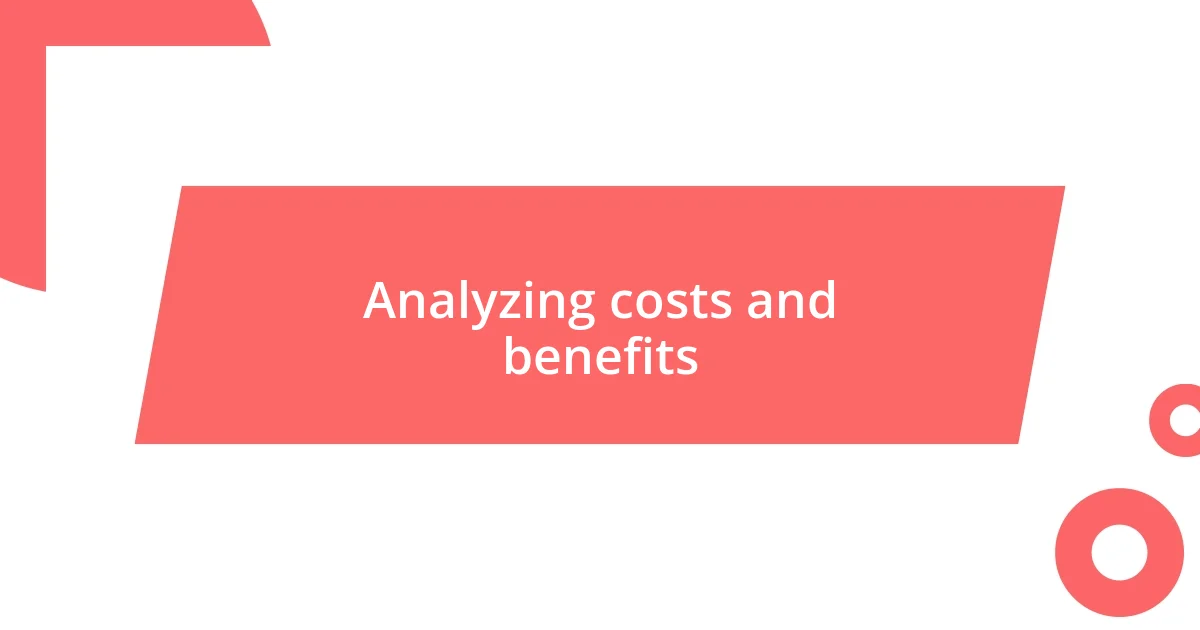Key takeaways:
- Profitability decisions require a holistic view, balancing short-term and long-term outcomes while aligning with business values.
- Key profit drivers include understanding revenue generation and navigating hidden costs effectively to create a sustainable strategy.
- Implementing data-driven decisions facilitates better insights and team alignment, ultimately enhancing strategic adaptability and profitability.

Understanding profitability in decisions
Profitability isn’t just about crunching numbers; it’s about understanding how those numbers affect the bigger picture. I remember a time when I was faced with a decision about expanding my product line. The initial excitement was clouded with doubts—was this move truly going to boost our profits or just drain resources? This experience taught me the importance of evaluating potential profitability against tangible outcomes and long-term goals.
Have you ever piloted a project that seemed promising but later revealed hidden costs? It’s a wake-up call to realize that profitability isn’t always immediate. For instance, I once invested in a marketing campaign that fell flat, and while I learned valuable lessons, I also had to consider how it impacted our overall budget. This kind of reflection emphasizes the need to weigh short-term gains against potential long-term consequences in every decision-making process.
When making choices, I often ask myself, “How will this impact our financial health in the future?” This mindset not only helps to clarify priorities but also fosters a deeper understanding of my business’s financial ecosystem. By framing decisions through the lens of profitability, I find clarity and direction, allowing me to make choices that resonate with both my values and financial goals.

Identifying key profit drivers
Identifying key profit drivers requires a keen eye on both revenue and costs. In my experience, I’ve found that analyzing sales data can reveal not just what products sell, but why they resonate with customers. For instance, I once discovered that our best-performing items came from a specific marketing angle—customers loved the story behind them. This realization shifted how I approached future campaigns.
Understanding costs is equally crucial. I recall a time when a supplier offered discounts for bulk purchases. Initially, it seemed like a fantastic deal, but after a thorough review, I saw the hidden shipping costs negated the savings. It’s those insights that remind me how every decision should be made with a clear view of both sides of the profit equation.
Regularly revisiting these elements ensures I remain aligned with what truly drives profitability in my business. By balancing revenue potential with cost considerations, I create a more resilient financial strategy that not only boosts profits but also reinforces long-term sustainability.
| Key Drivers | Description |
|---|---|
| Revenue Generation | Understanding which products or services generate the most sales and why they resonate with customers. |
| Cost Management | Identifying hidden costs associated with suppliers or operational aspects to maximize savings. |

Analyzing costs and benefits
Analyzing costs and benefits is a balancing act that I approach with a keen eye. For me, it’s not just about jotting down numbers; it’s about diving deep into how each cost impacts the potential benefits. I vividly recall a project where I was torn between investing in a new software tool or upgrading our existing systems. My initial excitement quickly turned to caution as I started to weigh not only the financial costs but also the time and training involved. It was a real eye-opener to realize that the long-term benefits of the new software far outweighed the immediate expenses and effort.
- Quantitative Analysis: Calculate exact costs versus expected returns to see the numerical impact.
- Qualitative Insights: Consider how decisions fit into the company’s vision or enhance customer experience.
- Scenario Planning: Explore different outcomes based on varying levels of investment or changes in market conditions.
In a different instance, when evaluating a potential partnership, I didn’t just look at the financial metrics. Emotional factors played a role too. The partnership could provide marketing support, but would it align with our brand values? Each choice needed thorough vetting to ensure it wouldn’t lead to hidden repercussions down the line. It’s these heartfelt considerations alongside the cold hard data that provide a holistic view of profitability in decision-making.

Setting clear profit goals
Setting clear profit goals is fundamental to making informed decisions. I’ve learned that profit goals shouldn’t just be numbers on a page; they need to resonate with my overall vision and mission. When I first set out to define these goals, I found myself asking, “What does profitability truly mean for my business at this stage?” I realized that aiming for a specific percentage increase in profit wasn’t enough; I needed to understand the underlying motivation behind these goals.
For example, I once aimed for a 20% profit margin increase based solely on industry standards. However, after deeper reflection, I recognized that my real priority was to reinvest a portion of those profits into community initiatives that aligned with my brand’s values. Shifting the focus allowed my team and me to feel more connected to our targets, making the journey toward reaching them not just a numerical challenge but a meaningful one. It’s amazing how clarity of purpose can transform the pursuit of profit into something that feels rewarding on multiple levels.
Moreover, having clearly defined profit goals helps in evaluating strategic decisions. I remember when I was considering expanding our product line. Instead of just estimating potential revenue, I checked how this decision aligned with my profit goals. Would this diversification dilute my focus or enhance it? With clearly articulated profit goals guiding me, I felt empowered to analyze the implications and choose a path that not only made financial sense but also aligned with my long-term vision. How often do we let short-term gains overshadow what we truly aspire to achieve? Setting clear profit goals reminds me to stay focused on the bigger picture.

Evaluating risk versus reward
When I assess risk versus reward, I often find myself in a position where I need to balance excitement with caution. I remember a time when I was exploring a high-stakes investment that promised significant returns. It sounded enticing, but as I delved into the details, I realized there were considerable risks that could jeopardize my resources. This reflection led me to ask, “Is the thrill of potential profits worth the chance of substantial loss?” This question didn’t just settle the debate for me; it illuminated the need for a careful, nuanced approach.
I engage in scenario planning to visualize how different decisions could unfold. For instance, when considering a new market launch, I played out potential outcomes: a smooth entry versus unforeseen obstacles. The more I thought about it, the clearer it became that while the rewards could be impressive, the risks of operational setbacks were substantial. This process isn’t just about calculating figures; it’s an emotional journey, weighing the excitement of growth against the anxiety of uncertainty. How often do we let ambition cloud our judgment? I’ve learned that a thoughtful evaluation can often lead to better decision-making.
Ultimately, risk assessment involves not only hard numbers but also gut feelings. I recall an instance where I opted against a promising collaboration after reflecting on how it felt. On paper, it checked all the boxes, but my intuition reminded me to consider the potential fallout. It’s these moments of internal dialogue that remind me that profitability is as much about emotional intelligence as it is about strategic calculations. Am I truly willing to gamble my vision for a fleeting gain? That’s the pivotal question that guides my decisions.

Implementing data-driven decisions
Implementing data-driven decisions has truly transformed my approach to profitability. One particular instance that stands out is when I adopted a new analytics tool that allowed me to track customer purchasing behaviors more closely. By diving into the data, I was able to uncover trends I’d never considered, like the unexpected popularity of a niche product. How often do we overlook hidden opportunities because we rely solely on gut feelings? This experience reinforced the idea that data can reveal insights that drive not just revenue but meaningful engagement with our customers.
Another crucial moment came when I started connecting financial metrics with real-time market data. In one case, our sales were plateauing, and I turned to the numbers for clarity. It was eye-opening to see that certain regions were performing significantly better than others. I realized that by adjusting our marketing efforts based on these insights, we could not only boost profitability but also tailor our strategies to better meet local demand. Have you ever felt lost with your business decisions? When data speaks, I’ve found it can provide the direction we often need.
Incorporating a culture of data-driven decision-making wasn’t easy. Initially, my team was hesitant to shift from their traditional methods. I remember holding a workshop where we analyzed both successes and failures through a data lens. When we looked at past campaigns and their actual outcomes, the team began to see the value of insights over intuition. Collective moments like this taught us that data doesn’t just inform decisions; it unites the team in a shared purpose. Isn’t it empowering to know that every choice we make can be solidified by evidence rather than just aspiration? That’s what keeps me excited about moving forward.

Reviewing and adjusting strategies
Reviewing and adjusting strategies is something I find incredibly crucial to maintaining profitability. I recall a project where our initial approach didn’t yield the expected results. After a few setbacks, I gathered my team to reassess our tactics. Running through our initiatives together felt like we were piecing together a puzzle. Sometimes, it’s easy to get attached to an idea, isn’t it? But stepping back and analyzing what wasn’t working helped us pivot in a new direction that ultimately increased our profit margins.
In my experience, being adaptable isn’t just beneficial; it’s essential. I remember a time when we had to shift our marketing strategy due to sudden market changes. Initially, I was hesitant, worried about disrupting our current momentum. Yet, I learned that reviewing our trajectory often reveals opportunities for innovation. Adjusting strategies can feel daunting, but isn’t it liberating when you find that flexibility leads to growth? Each time I’ve taken this leap, I’ve seen how responsiveness can create surprisingly prosperous outcomes.
I try to approach the review process as a learning experience rather than a chore. Engaging my team in open discussions has been eye-opening; different perspectives can illuminate blind spots. There was a moment when a junior team member suggested an adjustment during one of these sessions, and it turned out to be the game-changer we needed. I often think about how collaboration not only strengthens our strategies but also fosters a culture of shared ownership and accountability. Doesn’t it feel rewarding to see how collective insights can drive us forward?














